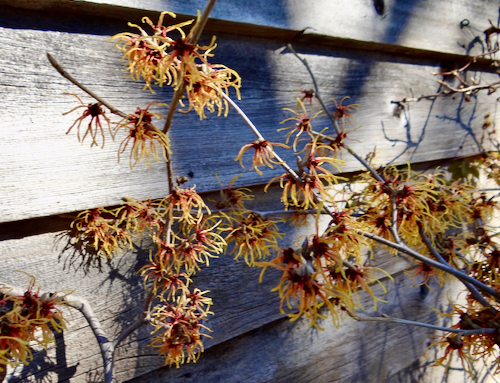
Plant of the Month - January 2023
GENERAL INFORMATION: Hamamelis × intermedia cultivars are crosses between Japanese witch hazel (H. japonica) and Chinese witch hazel (H. mollis). These are wonderful additions to the winter garden with flower colours ranging from pale yellow to oranges and reds, with some creams. Our North American native forest understory small tree, H. virginiana, flowers earlier in the fall. It is wonderful walking underneath (or beside) and looking up at the yellow leaves illuminated by the sun, highlighting the yellow flowers. The seeds of all these ripen in the fall giving rise to the name - Hamamelis, Hama = same time, Melis = apple or fruit.
Synonym: H. x intermedia ‘Copper Beauty’.
Common Name: Witch Hazel.

Hamamelis x intermedia 'Jelena'.
Life Cycle: Vase shaped deciduous Shrub.
Height: to 3-4 m, spreading to 3-4 m.
Bloom Time: Late December to March in Toronto.

Hamamelis x intermedia 'Jelena' - close up.
Flower Colour & Size: The spidery flowers are about 2.5 cm long, consisting of four thin wavy petals, alternating with the pointed sepals of the purple red calyx. The petals appear copper coloured but have red bases, then orange with yellow tips at maturity. The younger tips are red. They curl up in cold weather, only to reproduce the display when the warmth returns. Unfortunately, my cultivar is unscented.
Hamamelis x intermedia 'Jelena' summer leaves and fall colour.


Leaves: The short petioled oval leaves are rough, about 10 cm long, with wavy, almost toothed margins. Fall colour is brilliant orange scarlet in full sun but mostly yellow in shade.

Hamamelis x intermedia 'Jelena' fruit.
Fruit: The seeds are in a green capsule becoming brown and woody by October. One or two hard black elliptical seeds are projected 2-3 m when the capsule splits open. To collect, harvest the almost ripe capsules and place in a mesh bag in the warm.
Range & Habitat: H. japonica grows in the mountains in Japan. H. mollis is from forests in southern China. It is the most fragrant of the species. Our native H. virginiana is a small understory tree in wooded ravines.
CULTIVATION:
Plant: where it can be seen from your home, preferably on the south side so the winter sun will shine through illuminating the flowers.

Hamamelis x intermedia 'Jelena' Dec 31.
Light: Full sun to part shade.
Soil: Preferably acid, organically rich, well drained soils. All my cultivars grow happily in alkaline soil.
Water: Constant moisture is best.
USDA Hardiness: Zone 5-8.
Pruning: This cultivar may become too large. Prune in the spring after flowering to shape the shrub and to control size. Remove non-flowering branch tips to improve appearance before the buds open.
Propagation: By Seed. It will differ from the hybrid parent. Use repeated cycles of 20°C, then 4°C for 3 months each. Germination is very prolonged.
Vegetative - Cuttings are difficult to overwinter. Grafting or budding will produce plants faster. Layering is possible if you want only one or two plants.
Companion planting: Hellebores, spring bulbs and woodland perennials.
Problems: Insect damage to leaves, powdery mildew. Watch for suckers from grafted root stock.
References:
https://www.missouribotanicalgarden.org/PlantFinder
Royal Horticultural Society Plant Collector Guide: Witch Hazels. Lane, Chris: Timber Press, 2005. ISBN 0-88192-678-7.
Text and images supplied by Anna Leggatt (Toronto Master Gardener)
